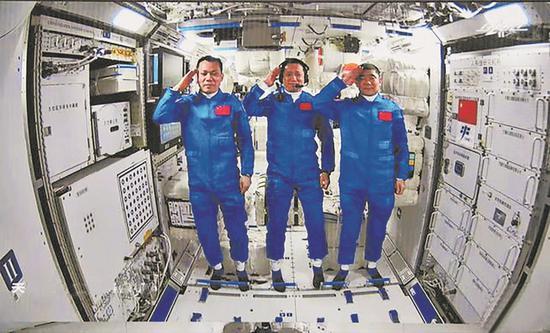神舟十二号载人飞船与中国空间站天和核心舱完成自主快速交会对接,航天员顺利进驻天和核心舱,标志着中国人首次进入自己的空间站。此次空间任务都有什么?中国近年来取得的太空成绩有哪些?未来空间站的发展方向是什么?一起揭秘你想要知道的知识点。

China Launches 3 Astronauts Toward New Space Station
There will soon be two places in orbit where astronauts live.
地球轨道上宇航员居住的地方将变为两个。
On a clear, sunny Thursday morning in the Gobi Desert, China launched three astronauts to rendezvous with the country’s nascent space station.
在一个晴朗、阳光明媚的周四上午,在戈壁沙漠,中国将三名宇航员送入太空,与刚刚建成的空间站对接。
They waved to cameras in their capsule as their trip to space began. Twenty-one minutes into the mission, the director of the launch center, Zhang Zhifen, announced that it was “a complete success.”
当他们的太空之旅开始时,三名宇航员从太空舱里向摄像机挥手。21分钟后,酒泉卫星发射中心主任张志芬宣布发射“圆满成功”。
If all now goes according to plan, they will rendezvous with China’s nascent space station later in the day, beginning what is planned to be a continuous Chinese presence in Earth’s orbit for at least the next decade.
如果一切都按照计划进行,他们将于今天晚些时候与中国刚刚建立的空间站对接,开始中国在地球轨道上持续存在至少十年的计划。
The space station, called Tiangong, or Heavenly Palace, joins the International Space Station, the project led by the United States and Russia that has been steadily occupied for more than two decades.
名为“天宫”的空间站将与国际空间站(International Space Station)并列,后者是由美国和俄罗斯领导的项目,已经连续使用了二十多年。
Thursday’s launch is the third of 11 missions planned to complete construction of China’s first long-term outpost in space before the end of next year.
周四的发射是中国第一个长期空间站建设的11项任务中的第三项,该建设计划在明年年底前完成。

What did China launch?
关于神舟十二号
The astronauts soared into space aboard Shenzhou-12, a spacecraft that will dock to the two modules launched earlier. It will effectively become another piece of the space station, which is orbiting 242 miles, or 390 kilometers, above Earth. (The International Space Station is slightly higher at 248 miles.)
宇航员乘坐“神舟十二号”飞船飞入轨道,该飞船将与之前发射的两个模块对接。它将实际成为空间站的另一部分,该空间站在地球上空242英里(或390公里)的轨道上运行。(国际空间站稍高,在248英里[400公里]。)
The Shenzhou, modeled on the Soviet-era Soyuz spacecraft, though larger, consists of three modules, including a re-entry craft that will bring the astronauts back to Earth. In addition to the crew, it is carrying basic supplies for a long-term stay, including 120 different meals with “balanced nutrition, rich variety, good flavor and a long shelf life,” according to Ji Qiming, an assistant to the director of the China Manned Space Agency.
神舟飞船以苏联时代的联盟号飞船为蓝本,不过更大,由三个模块组成,包括一个将宇航员带回地球的返回舱。据中国载人航天工程办公室主任助理季启明介绍,除了航天员外,飞船还携带为长期太空停留准备的基本用品,包括“营养均衡、品种丰富、口感良好、长保质期”的120种不同的航天食品。
A related spacecraft, Shenzhou-5, carried the first Chinese astronaut to space in 2003, making China the only country besides the United States and the Soviet Union and, its successor, Russia, to complete the feat independently. China has since carried out five more crewed flights into orbit, the last in 2016.
2003年,神舟系列另一航天器“神舟五号”将中国首位宇航员送上太空,使中国成为除美苏及后来的俄罗斯之外唯一独立完成这一壮举的国家。此后,中国又进行了五次载人飞行进入轨道,最后一次是在2016年。

Who are the astronauts?
宇航员都有谁?
The commander of the mission is Maj. Gen. Nie Haisheng, 56, of the Astronaut Brigade of the People’s Liberation Army. He is a former fighter pilot and veteran of two previous Shenzhou missions, in 2005 and 2013.
现年56岁的聂海胜担任指令长。他曾是战斗机飞行员,在2005年和2013年两次执行神舟任务。
Maj. Gen. Liu Boming, 54, is another space veteran, having been part of the mission in 2008 that included China’s first spacewalk. That feat was accomplished by another astronaut, Maj. Gen. Zhai Zhigang, but General Liu briefly emerged from a portal to become the second Chinese astronaut to touch space.
54岁的刘伯明也是一位航天老兵,参加过2008年的神舟任务,其中包括中国首次太空行走。这一壮举是由另一位航天员翟志刚完成的,但短暂出舱的刘伯明还是成了中国第二位接触太空的宇航员。
The third crew member is Col. Tang Hongbo, 45. He has twice been a backup crew member for Shenzhou missions but is making his first trip into space. He noted that his training had now lasted 11 years. “There is pressure for sure,” he said, “but I firmly believe that pressure is motivation.”
第三位是45岁的汤洪波。他曾两次担任神舟任务的备份航天员,这是他的首次太空之旅。他说自己已经训练了11年之久。“压力肯定有,”他说。“但我坚信,压力就是动力。”

How long will the trip to orbit last?
进入轨道要耗时多久?
The China Academy of Space Technology told The Global Times, a state newspaper, that the trip to the orbital module would take about 6.5 hours. When it arrives on Thursday evening, the spacecraft will autonomously dock with the station.
中国空间技术研究院在接受官方报纸《环球时报》的采访时表示,飞行至轨道舱将耗时约6.5小时。当它于周四晚间抵达后,飞船将与空间站自主对接。
That’s similar to the time of a flight in May of a cargo vessel called Tianzhou, which docked with the core module about eight hours after it launched. It carried several tons of supplies to equip and sustain the station, which will have three bedrooms, a bathroom, and places for the astronauts to eat and exercise.
这与今年5月发射的“天舟”号货运飞船的飞行时间类似,“天舟”号在发射约八小时后与核心舱完成对接。它运载了数吨物资来装备和维持空间站,后者将设有三个卧室、一个卫生间,以及供宇航员吃饭和锻炼的地方。

How long will they stay and what will they do aboard the station?
宇航员将在空间站驻留多久?期间会做些什么?
The crew of Shenzhou-12 is scheduled to spend the next three months in orbit. After that a second crew of three astronauts will replace them.
“神舟十二号”的宇航员计划在轨道上度过接下来的三个月。在那之后,另外三名宇航员将替代他们。
The station remains under construction, so the astronauts’ main tasks will effectively be to continue to build it, installing equipment like cameras and testing various functions, including life support and waste management. They are scheduled to conduct two spacewalks as part of that effort.
空间站仍未建成,因此宇航员的主要任务是继续建造,安装摄像机等设备,并测试包括生命维持和废物处理在内的各种功能。在任务进行期间,他们计划进行两次太空行走。
General Nie, the commander, told reporters in Jiuquan on Wednesday that this mission would be more arduous and challenging than his previous two.
周三,指令长聂海胜在酒泉对记者表示,这次任务比他之前两次任务都更为艰巨、更具挑战性。
“We will not only have to arrange the core module, the ‘space home,’” he said, “but also to carry out a series of key technology verifications.”
“我们不仅要把核心舱这个‘太空家园’布置好,”他说。“还要开展一系列关键技术验证。”

What is China’s space station and what will it do?
中国的空间站将做什么?
China’s first two space stations were short-lived prototypes, but the Tiangong is intended to operate for at least a decade, joining the International Space Station.
中国最初的两个空间站都是寿命较短的原型,但“天宫”号空间站计划和国际空间站一样,运营十年以上。
The Chinese station will serve as an orbiting laboratory for the country’s space program, allowing it to perfect operations and conduct new experiments — at least nine of them, so far, with international partners. Officials have said that once the station is completed next year, they will consider ferrying foreign astronauts to the station.
这一空间站将作为中国太空计划的轨道实验室,可以完善操作并进行新实验——到目前为止,它与国际合作伙伴至少进行了九次实验。官员表示,等到明年完工,他们将考虑运载外国宇航员至该空间站。
Mr. Ji, the assistant director, acknowledged at a briefing that China was “a latecomer” when it came to developing an orbiting space station, a feat the United States and Soviet Union accomplished decades ago. He noted, however, that China benefited from “latecomer advantages,” presumably the experiences of those previous stations.
中国载人航天工程办公室主任助理季启明在发布会上承认,中国空间站建设“起步较晚”,美国和苏联在几十年前就已经完成了这一成就。但他指出,中国也有“后发优势”,或许是能够吸取以前空间站的经验。

What else is China’s space program doing?
中国的太空计划还在做什么?
China’s space program has had a very successful series of launches and landings in recent years.
近年来,中国太空计划完成了一系列非常成功的发射和着陆。
Most recently in May, it set down Zhurong, a robotic rover, on the surface of Mars. That made it only the second country, after the United States, to accomplish such a technical feat, as many Mars landing attempts have ended in crashes.
最近一次是在5月,“祝融号”火星车在火星表面着陆。这让中国成为继美国之后第二个完成这一技术壮举的国家,此前许多火星着陆尝试都以坠毁告终。
Another robotic Chinese mission landed on the moon in December, collected lunar rocks from the surface and returned them to Earth weeks later. That made China only the third nation, after the United States and the Soviet Union, to complete such a round-trip.
去年12月,中国另一架漫游车在月球着陆,收集了月球表面岩石,并在几周后将其带回地球。中国也因此成为继美国和苏联之后第三个完成这一往返任务的国家。
These successful endeavors have added to the likelihood that China will keep to its proposed timelines for other deep space missions. In addition to a series of robotic journeys to the lunar surface, the country will aim to collect samples from a near-Earth asteroid and return them to Earth around 2025 — something Japan has done twice. It also intends to launch a mission around 2030 to collect samples from Mars and bring them back to Earth, something NASA and the European Space Agency are collaborating on in the coming years as well.
这样的成功尝试提升了中国继续执行其他深空任务计划表的可能性。除了一系列登陆月球表面的漫游车任务之外,中国还计划在一颗近地小行星上收集样本,并在2025年左右返回地球——日本曾两次完成此任务。中国还打算在2030年前后完成一次发射任务,从火星上收集样本并将其带回地球,这也是NASA和欧洲空间局(European Space Agency)未来几年的合作项目。
What is the future of the International Space Station?
国际空间站未来会怎样?
The International Space Station, led by the United States and Russia with contributions from 13 other nations, was originally scheduled to be retired in 2015, just four years after construction was completed. The lifetime was subsequently extended to 2020 and then through 2024. Recent legislation passed in the U.S. Senate proposed another extension, to 2030. A feasibility study by NASA concluded that the aging station could continue to operate through at least 2028.
由美国和俄罗斯主导、另外13国出资建造的国际空间站原本计划于2015年停运,距离其建成仅过四年。它的使用寿命后来被延长到2020年,随后又被延长到2024年。美国参议院最近通过的一项法案提出了又一项延长至2030年的计划。NASA的一次可行性研究结果表明,这个老化的空间站至少可以持续运行到2028年。
In 2018, the Trump administration said it wanted to end direct federal financing of the International Space Station after 2024 and shift orbital operations to private space stations. After widespread criticism, NASA officials insisted that this was not a fixed deadline and that the current station would not be abandoned until its successors were operational.
2018年,特朗普政府称要在2024年后停止联邦政府对国际空间站的直接资助,并将轨道运营转交给私人空间站。在遭到广泛批评后,NASA官员坚称这并非固定的最后期限,在新空间站投入使用前,现有空间站不会被放弃。
Russian officials have in recent months offered conflicting statements about their plans. At first, they said they wanted to withdraw from the International Space Station in 2025. Later they softened assertions, saying that the departure would not be abrupt.
近几个月来,俄罗斯官员对其太空计划发表了相互矛盾的声明。起初,他们表示要在2025年退出国际空间站。后来,他们软化了说辞,称不会突然退出。
During a news conference at the Global Space Exploration Conference in St. Petersburg, Russia, this week, Dmitri Rogozin, head of the Russian space agency, said Russia was “generally not against” continuing to participate on the space station but said it might not make sense if the cost of maintaining the aging structure skyrocketed.
本周,在俄罗斯圣彼得堡举行的全球航天探索大会(Global Space Exploration Conference)的新闻发布会上,俄罗斯国家航天公司总裁德米特里•罗戈津(Dmitri Rogozin)表示,俄罗斯“总的来说不反对”继续参加国际空间站,但他声称,如果维护老化结构的成本飙升,可能就没什么理由继续下去了。
来源:纽约时报

